Getting the right rings the first time around is a money and time saver. Not only do you need the right diameter to fit the scope tube, getting the right height is just as important.
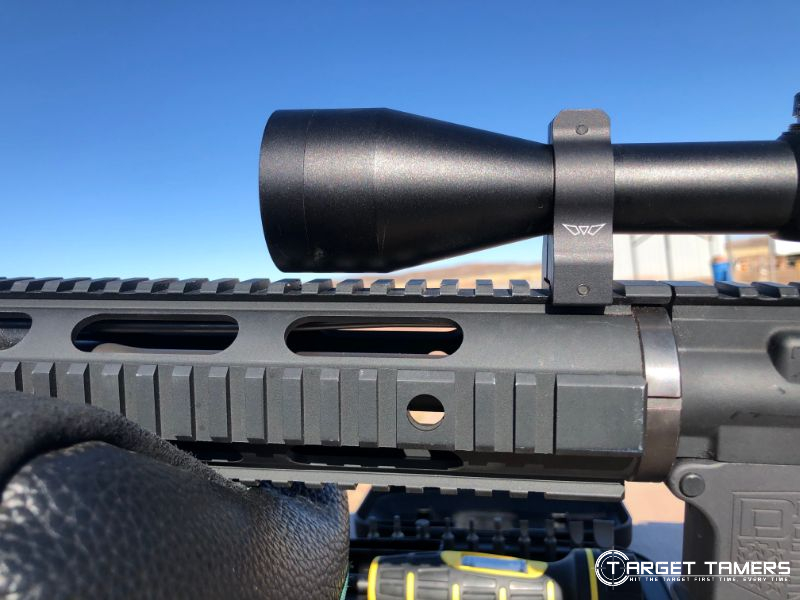
In general, the goal is to get the scope as close to the bore as possible without the objective bell touching the barrel. Mounting low helps to maintain a proper cheek weld. There are formulas to measure the right scope ring height, but personalization is also required.
There’s more than just math involved as you must account for your cheekweld. I go over some formulas to measure scope ring height, what happens if scope mounts are too high or too low, and how the stock will affect what rings to choose.
How to Measure Scope Ring Height
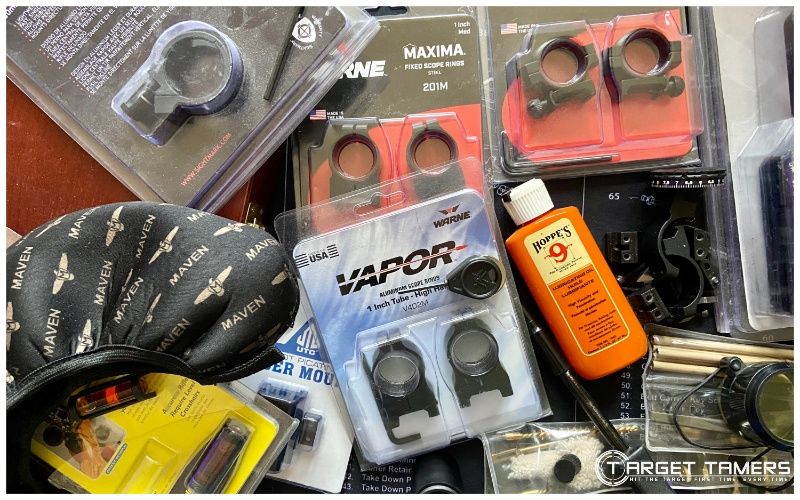
You could just trust that low, medium, high, and extra high sizes are standard and universal, but you’ll soon find out the hard way that they’re not. This is because measuring ring height is different between manufacturers. However, there are two methods commonly used to get this measurement.
The best way to know how you’re getting the right height rings are to calculate the height you need and then determine where that measurement falls into the height category for the ring/mount manufacturer you’re considering.
Ring Height Categories
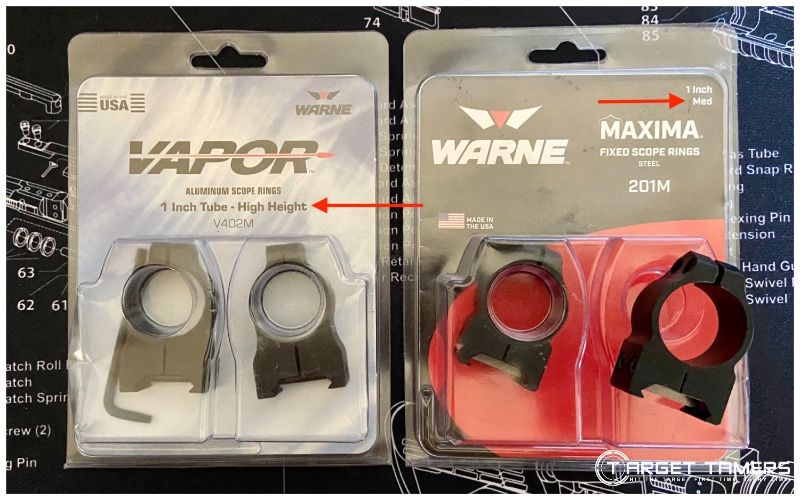
Though somewhat universal, overall ring height is based off the objective lens diameter. This is the front end of the scope that is usually flared. The height ensures the objective bell will clear the barrel. Some external variables like objective lens caps must be considered.
The following are guidelines as ring height to objective lens diameter sizes vary between manufacturers and even between ring series and models.
- Low: 40-42mm
- Medium: 42-44mm
- High: 50-52 mm
- Super High: 52+ mm
Figuring out what the objective lens size is easy – it’s in the scope model name or what I repeatedly call the ‘configuration.’
Example: Vortex Crossfire 1-4x24
The first two numbers separated by a dash indicates variable magnification starting at 1x and maxes out at 4x. The last number after the ‘x’ indicates the objective lens diameter. In this case, the Vortex Crossfire has a 24mm objective.
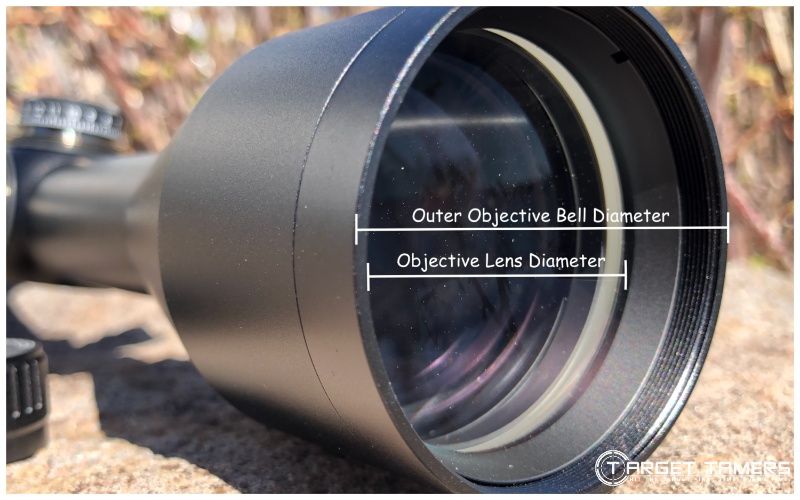
Tip:
This is just the size of the objective lens, the piece of glass at the front end of the scope. This is not the actual size of the objective bell – the diameter from the outer edges of the scope where the objective lens is housed.
To learn more about what scope numbers mean, check out our guide for more details.
Scope Tube Size
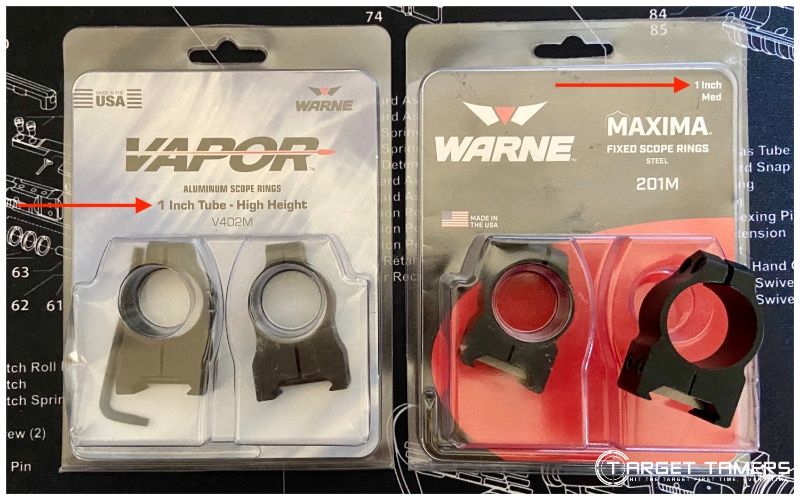
Another point to consider is that most ring heights are measured and disclosed in the specs in inches. Yet many larger tube scopes are measured in millimeters. To make appropriate calculations and conversions, it’s helpful to know the formula to convert millimeters to inches and vice versa.
| MM to INCHES | INCHES to MM |
|---|---|
| Formula: X (variable number) / 25.4 (constant) | Formula: X (variable number) x 25.4 (constant) |
| Ex. 34 mm / 25.4 = 1.34 inches | Ex. 1 inch x 25.4 = 25.4 mm |
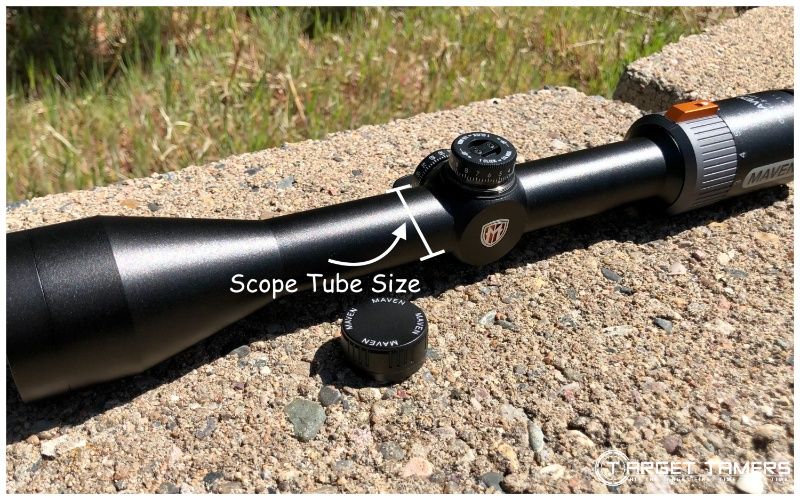
Common scope tube sizes are:
- 1” (25.4 mm)
- 30 mm
- 34 mm
And then there are some not so common, larger ones…
- 35 mm like the Leupold Mark 5HD 5-25x56
- 36 mm like the Hensoldt 3.5-26x56 FF
- 40 mm like the Valdada IOR Terminator Tactical 12-52x56
How to Calculate Ring Height
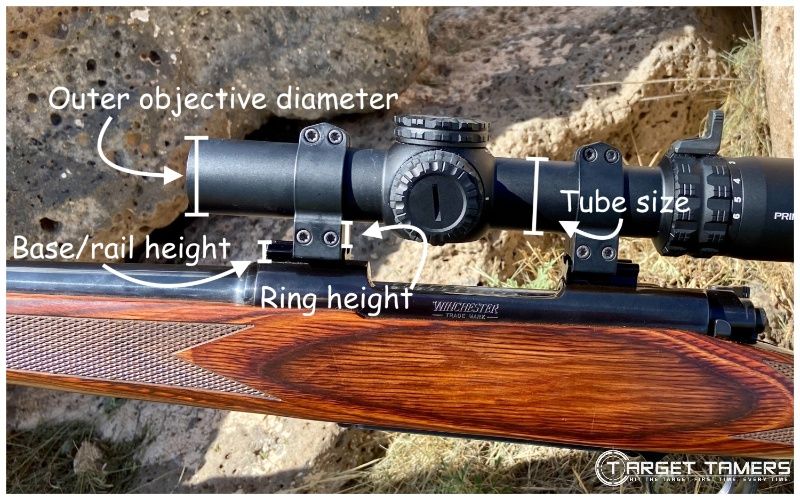
One of my favorite formulas is actually from Warne. One, I buy Warne rings, and two, they provide a calculation that doesn’t require you to have the rings in hand to measure. The idea is to get a measurement based on your rifle and scope, and then purchase the right rings.
It’s way easier to use their online calculator, but if you want to know the math, here it is. This formula is basically a measurement for the ring height from the base to the ring edge (saddle) – not to the ring center.
Let’s do an example on the Maven CRS.2 4-16x44 riflescope on a bolt action rifle with wood stock, no cheekrest, and a two-piece mount. Important specs to know:
- Objective lens: 44 mm
- Outer objective size: 52.6 mm
- Tube size: 1”
- Rail height from base: 3.81 mm (0.150”)
| Objective Radius (OR) Minus Tube Radius (TR) Minus Base/Rail Height (BH) = Minimum Ring Height (MRH) |
|---|
| OR – TR – BH = MRH |
To the get the radius, simply divide the dividend by 2.
| Measurement | Conversion to Inches | Radius (Divide by 2) | |
|---|---|---|---|
| Outer Objective | 52.6 mm | 52.6 / 25.4 = 2.07” | 2.07 / 2 = 1.03” |
| Tube | 1” | 1” | 0.5” |
| Base/Rail Height | 0.150” | 0.150” | N/A |
| 1.03” – 0.5” – 0.150” = 0.38” Minimum Ring Height Required | |||
Thanks to the math, I know I need a ring height of at least 0.38”. Since many Warne medium rings are in the 0.375” range, I’ll settle for that at the minimum. Now, I can choose the appropriate rings for my scope.
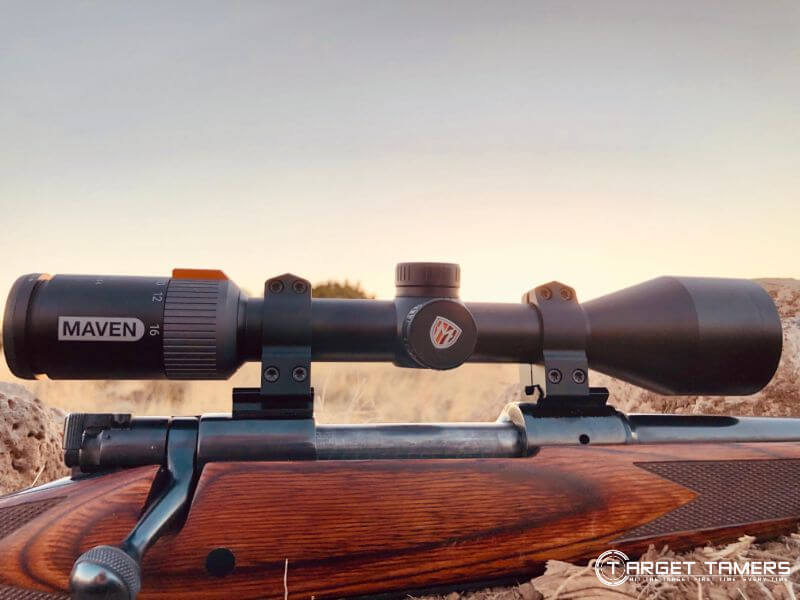
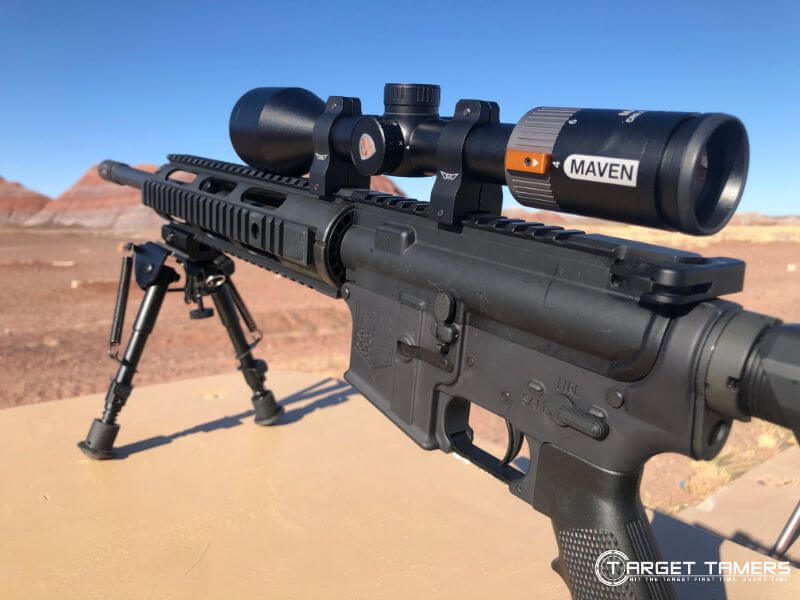
What did I actually use? On my 30-06, I used… tada! 1” Medium rings that have a 0.375” height. I found this to be perfect for my natural position, and the scope cleared the barrel, and the action was clear.
Tip:
On an AR-15, I’d recommend a cantilever mount since getting good eye relief forced my front mount on the handguard. The medium height rings weren’t enough to clear the rail. I used some 1” High rings with a 0.225” height. It just barely cleared the rail, but I would go a size up if I were using this scope with rings on an AR.
Measure From Base to the Ring Edge
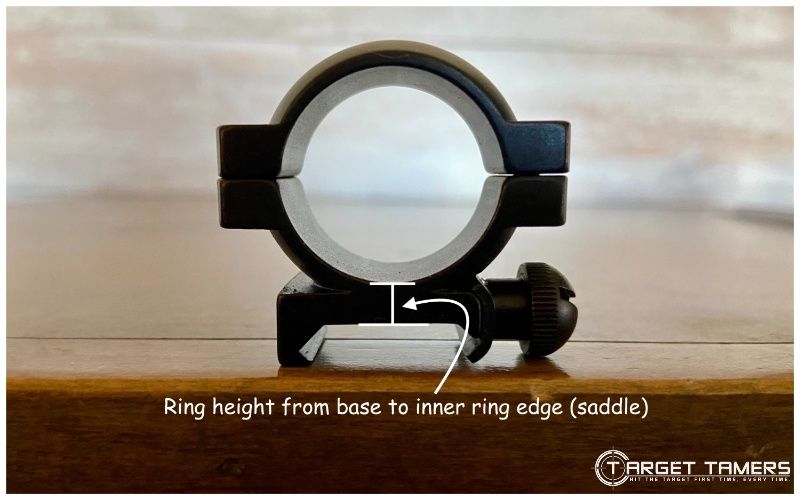
There are several formulas, but one of the most common you’ll find is to measure the rings from the base to the ring edge (saddle), like how Warne measures their ring heights. The common formula is to take the tube size, divide it by 2, and add the scope ring height.
If just calculating the scope ring height was all it took, there would be less math involved. This isn’t the case as we need to take the result and account for the objective lens size to ultimately ensure there will be clearance between the objective bell and the barrel.
Let’s do an example on the Vortex Strike Eagle 1-8x24 riflescope. Rings to consider: Medium height rings with 0.375” (9.525 mm) base to saddle height. Important specs to know:
- Objective lens: 24 mm
- Outer objective size: 29.97 mm (1.18”)
- Tube size: 30 mm (1.18”)
| (Tube Size / 2 ) + Ring Height = Scope Ring Height |
|---|
| Ex. (30 mm tube / 2 ) + 9.525 mm = 24.525 mm (0.97”) |
| Objective Lens / 2 = Optical Center of the Scope to Inner Objective Lens Edge |
| Ex. 24 mm / 2 = 12 mm (0.47”) |
| Scope Ring Height – Optical Center of the Scope to Inner Objective Lens Edge = Clearance |
| Ex. 24.525 mm – 12 mm = 12.525 mm (0.5”) of clearance |
I would say that this is a rough estimate because the objective bell wasn’t used – just the lens. A better determination would be to use the outer objective diameter and divide by 2. This measurement is usually between 2-8 mm more than the objective lens diameter.
Tip:
Where do you find the spec for the outer objective diameter? It should be listed in the specs on the manufacturer’s website. It might also be displayed in a diagram of the dimensions. It could be measured in mm or inches. If you cannot find this number in the specs, you can always use calipers, a ruler, or guesstimate between 2-8 mm more than the objective lens diameter.
Let’s try this example again with the new outer objective diameter and do both mm and inch calculations.
| MM Calculations |
|---|
| (30 mm / 2 ) + 9.525 mm = 24.525 mm |
| 29.97 mm / 2 = 14.985 mm |
| 24.525 mm – 14.985 mm = 9.54 mm of clearance (same as 0.375”) |
| INCH Calculations |
|---|
| (1.18” / 2 ) + 0.375” = 0.965” |
| 1.18” / 2 = 0.59” |
| 0.965” – 0.59” = 0.375” of clearance (same as 9.54 mm) |
Now 9.54mm is different to 12.525mm that we got the first time. This means something when every bit of clearance matters. Based off these calculations, you’ll know that you can use rings with a 0.375” height from the base to the ring edge with a 30mm scope tube that has a 24 mm lens aka almost any LPVO!
Measure From Base to the Ring Center
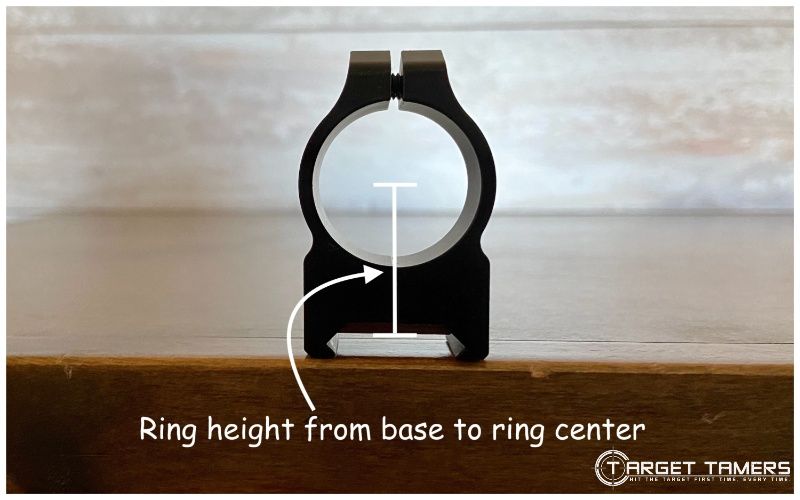
Some manufacturers measure ring height from the base to the very center of the rings. If you’re looking at ring height specs based off this method of measurement, use the formula to calculate scope clearance. A positive result means it’ll clear. A negative result means it won’t!
| (Base/Rail Height + Ring Height) – (Objective Diameter x 0.5) = Expected Clearance |
|---|
Let’s do an example.
Primary Arms GLx 1-6x24 scope on AR-15 with Vortex Sport Cantilever Mount. Important specs to know:
- Objective lens: 24 mm
- Outer objective diameter: 29.97 mm (1.18”)
- Tube size: 30 mm (1.18”)
- Rail height on my AR: 6.35 mm (0.25”)
- Ring height: 37 mm (1.46”)
We’ll do mm measurements and inch measurements separately for the sake of it.
| Measurement in MM | Measurement in INCHES | |
|---|---|---|
| Base/Rail Height | 6.35 mm | 0.25” |
| Ring Height | 37 mm | 1.46” |
| Outer Objective Diameter | 29.97 mm | 1.18” |
| Formula: | (Base/Rail Height + Ring height) – (Objective diameter x 0.5) = Expected Clearance |
| Measurement in MM | (6.35 mm +37 mm) – (29.97 mm x 0.5) = 28.37 mm of clearance! |
| Measurement in INCHES | (0.25” + 1.46”) – (1.18” x 0.5) = 1.12” of clearance! |
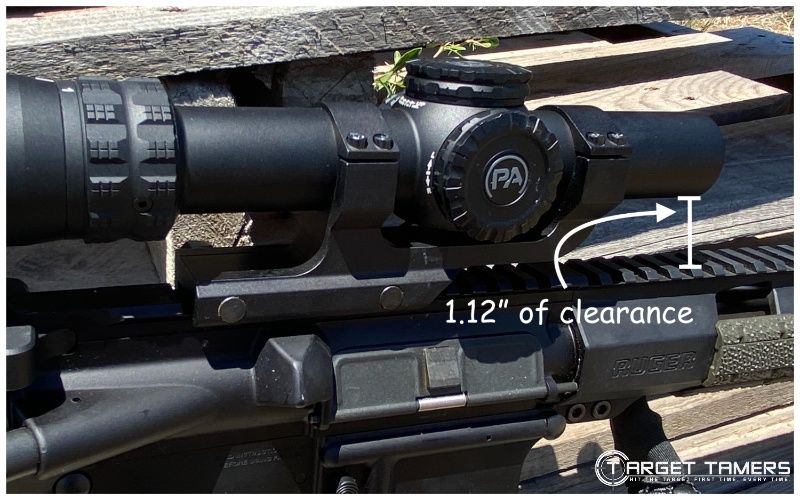
Note: Comparing results by doing conversions…
28.37 mm / 25.4 = 1.11692913385268”
Let's call that 1.12"? Awesome!
Another Formula from Base to Ring Center
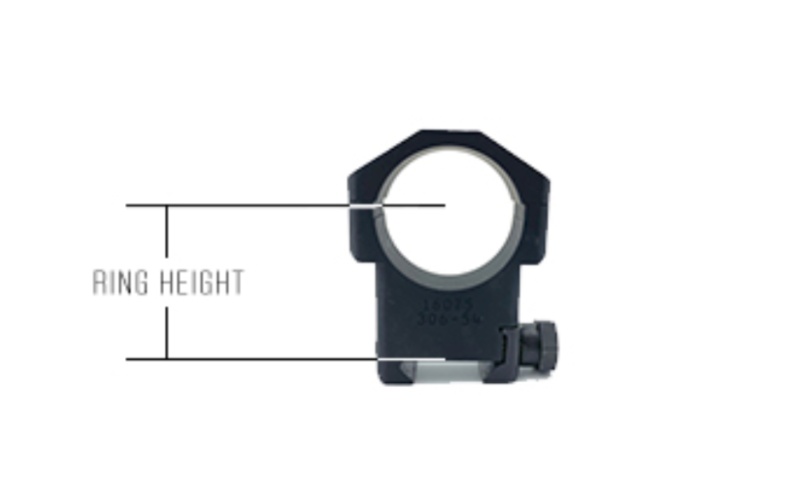
You can also determine the minimum amount of clearance you need based off the riflescope height. This height is actually the distance of the optical axis of the scope to the outer edge of the objective bell. Knowing this height can help measure another way to determine the right ring height.
Example:
Vortex Strike Eagle 1-8x24 on my AR-15 using the Vortex Sport Cantilever mount. Important specs to know:
- Objective lens: 24 mm
- Outer objective diameter: 29.97 mm (1.18”)
- Tube size: 30 mm (1.18”)
- Rail height on my AR: 6.35 mm (0.25”)
- Ring height: 37 mm (1.46”)
Tip:
At this point, you can see that a lot of the information is the same as most of us are using the same rifles when we get a new scope or rings. It’s helpful to keep this information written down so that when you want to upgrade rings or make changes to your setup, you already have some of these specs on hand.
| Outer Objective Diameter / 2 = Scope Height |
|---|
| 29.97 mm / 2 = 14.99 mm |
| Base/Rail Height + Ring Height = Distance from Center of Rings to Rail |
| 6.35 mm + 37 mm = 43.35 mm |
| Distance from Center of Rings to Rail – Scope height = Clearance from Objective Bell to Rail |
| 43.35 mm – 14.99 mm = 28.37 mm (1.12”) clearance |
As you can see, the math that was just done here led to the same results as the previous formula - (Base/Rail Height + Ring Height) – (Objective Diameter x 0.5) = Expected Clearance! It just goes to show that you can formulate this information in a couple different ways.
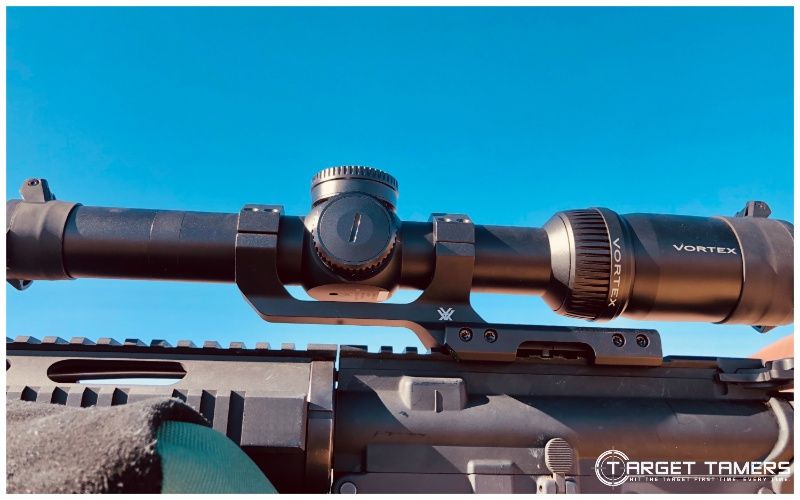
Also, if you’re using scope caps or a rail with built-in cant, either in MOA or MRAD, this calculator can help you figure things out further when using the measurement from the base to the ring center.
Can a Scope be Mounted Too High?
Scopes that are mounted in rings that are too high leaves a lot of room between the objective bell and the barrel. This can be cause for concern for those who aren’t deliberately running their rig this way.
But we’re not here to debate the chin versus cheek weld issue. The most obvious effect of running rings higher than necessary is that a natural position is likely to be awkward with high mounting. This means that your cheekweld is probably higher than normal. This forces you to raise your head to find the optical axis of the scope, and this position may not be repeatable affecting image quality and accuracy.
Can a Scope be Mounted Too Low?
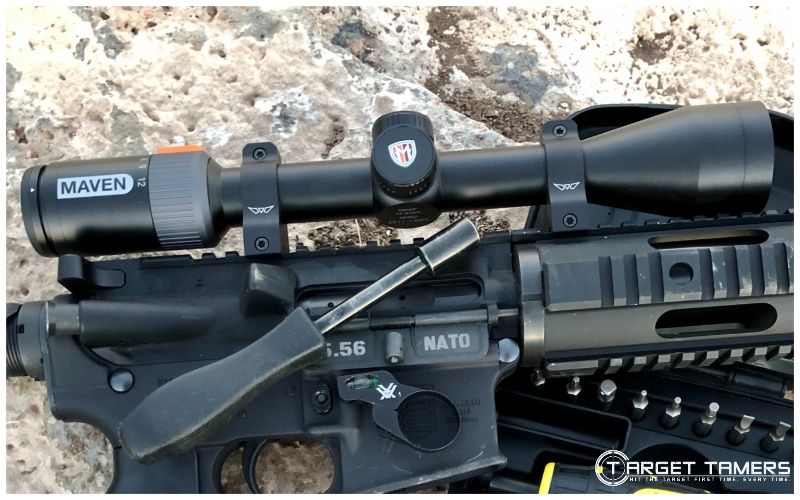
Scopes need to completely clear the barrel and the action on a bolt rifle when mounted. Most of the time, using rings that are too low can be avoided since the scope won’t seat into the base rings correctly. The objective bell will hit the handguard or the barrel before the scope can be seated.
Rings that are too low but used anyway will either cause the scope to touch the barrel, screws are not properly torqued down, or the scope tube is cinched at the rings from improper mounting.
Some of the most obvious effects of too low rings include inability to mount the scope, screws come loose, and loose screws result in a scope that moves within the rings. This affects zero retention and accuracy. Also, you’ll squish your cheekweld down forcing an unnatural position and difficulty aligning your eye with the scope’s optical axis.
Bolt Action Rifles & Non-Adjustable Stocks
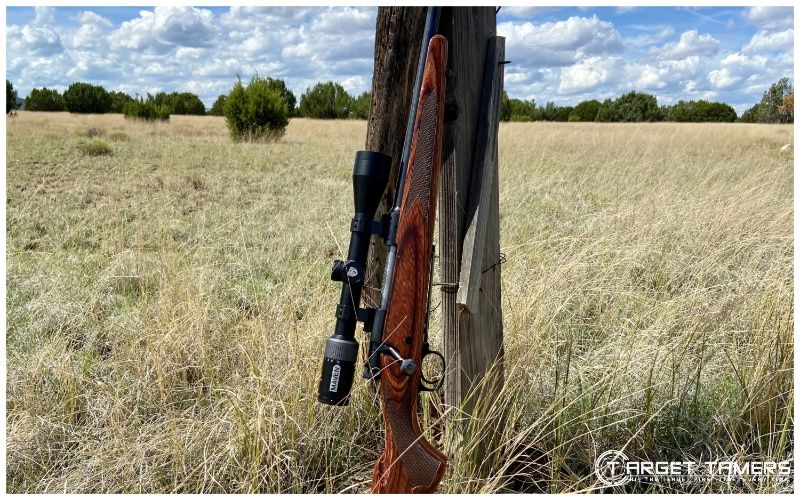
Traditional style stocks on a bolt action rifle can be slightly angled or aligned lower than the actual barrel axis or the action. Usually low to medium rings are all that’s needed to get the scope mounted with minimal but acceptable clearance.
Rifles with Adjustable Cheek Rests
Cheek risers, cheek rests, cheek pieces – same thing. The idea of using one is to raise your cheek weld to properly use a mounted scope. With this configuration, medium to high rings are usually needed.
Even if there’s a good deal of scope clearance from the barrel or handguard, the adjustable cheek rest will help to get a proper cheekweld for a rapid and natural position that’s aligned with the scope’s optical plane.
Check out our short brief on cheek rests here by scrolling down to tips 21 & 22!
Rifles with Straight Stocks
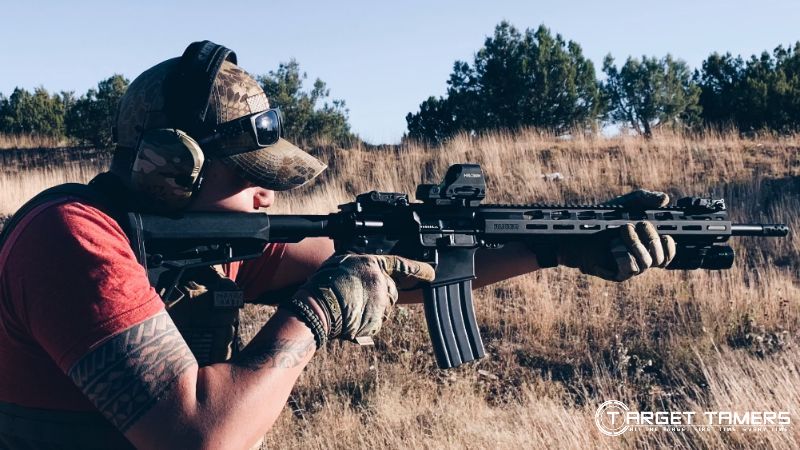
Rifles like the AR-15 and AR-10 have stocks that are in line with the action and barrel. This requires ring heights that are much taller than rings that are mounted to other rifles. High to super high rings are likely needed but a cantilever mount is usually the recommendation.
Rails with Built-In MOA/MRAD
Canted rails have built-in MOA or MIL/MRAD that provides a slant. As a result, the front of the scope mounts lower whereas the rear of the scope mounts higher. Although the goal is to still maintain a low mounting position, extra clearance is needed.
| Tan Angle (°) x Length from Edge of Scope Base to End of Objective Bell = Additional Clearance Needed |
|---|
| Ex. Tan (0.3333) x 5” = 0.029” of clearance for a 20 MOA rail |
The following chart is a cheat sheet for MOA canted rails:
| BASE | 20 MOA | 30 MOA | 40 MOA |
|---|---|---|---|
| (°) | 0.3333 | 0.5 | 0.6666 |
Objective Lens Caps
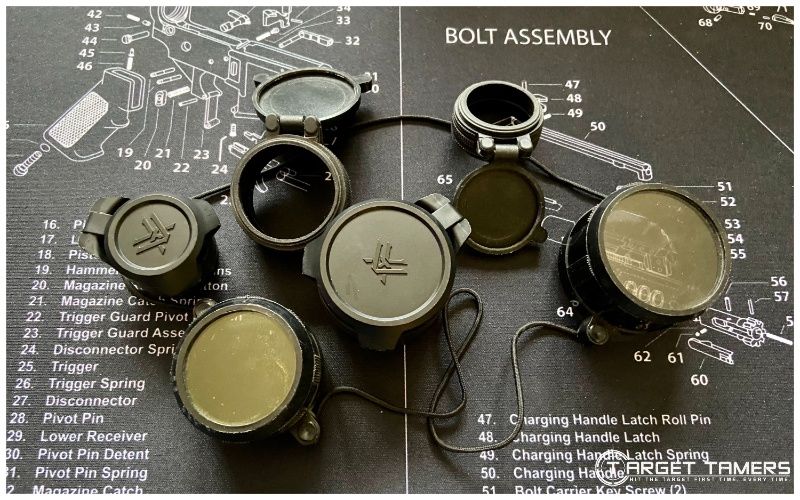
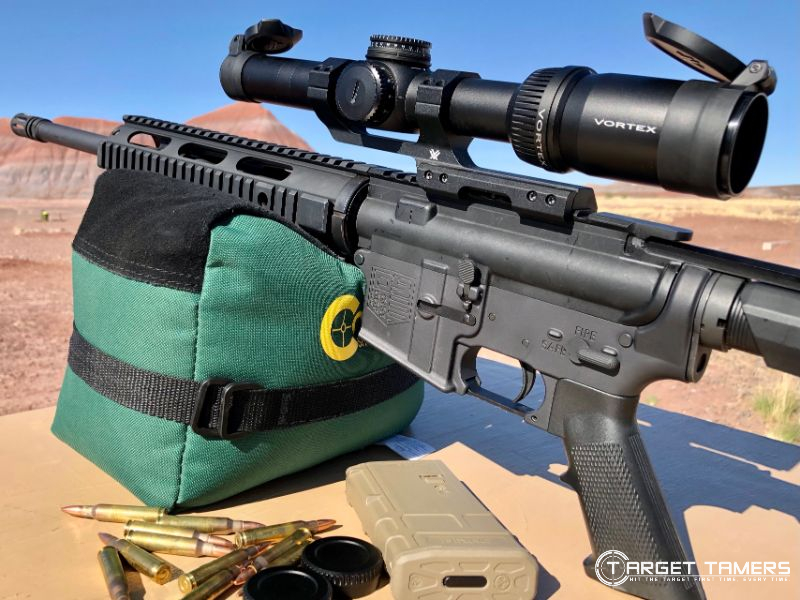
Don’t forget to take into account the thickness of scope lens caps. When every bit of clearance is needed for a scope, you might not be able to attach bikini covers or keep flip-up caps on when the scope is mounted. Some online calculators consider the cap thickness measurement to the calculation for the right ring height.
FAQ's
In general, there are two common methods to measuring scope ring height: measure from the base to the center of the ring or from the base to the inner edge (saddle) of the lower ring. There are several formulas that can be used but manufacturers disclose ring height by one of these measurements.
On average, high scope rings are needed for the AR-15 and AR-10. The most common scope ring heights for the MSR is 1.4-1.5” though there is much discussion on height variations to suit one’s comfort levels.
The rule of thumb is to mount the scope as close to the barrel as it can get without touching. This is good advice for the majority of shooters. Taller rings or mounts are needed for flattop rifles, rifles with canted rails, or rifles with stocks that are slightly lower than the action or barrel axis.
Use the ring height formulas or online calculators to determine how much clearance you need. If you have extra rings, a little experimentation will go a long way in getting a fair idea of ring height and how it works with your cheek weld.
Overall, heat transference and mirage caused by the barrel can interfere with scope performance and image quality. Unintentional contact (flexing) between the two under recoil can occur. However, it’s recommended that there should be at least 0.125” clearance though 0.25” is better.
This might be a bigger issue for match/competition shooters than hunters, and it also depends on how comfortable your weld and eye height is with minimal clearance.
There is some math involved but common methods to measure ring height from the receiver or a rail is to use coins (pennies, nickels, dimes), modeling clay, business cards, etc. Stack them on the receiver, lay the scope on top, and add or remove the material as needed to get the right scope height.
Divide the tube size by 2 and add the measured thickness of the chosen material. You can measure with a ruler or calipers. Don’t forget to account for the objective bell!
Measuring Ring Height: What Does Your Weld Tell You?
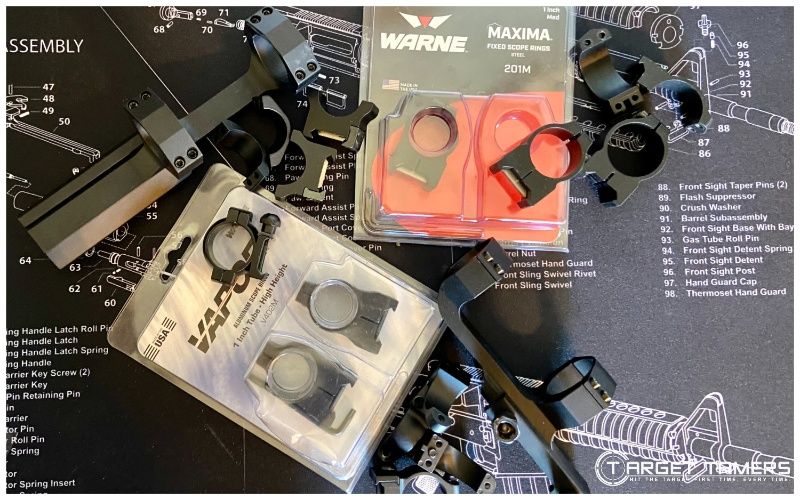
Consider for a second that your cheekweld is off. You’re smushing your face into the stock or lifting your face so that your chin is elevated. Even with the lowest rings and scope clearance with both the action and barrel, you may need to go a size up for several reasons.
While there is the math and formulae to help measure scope ring height for your setup, a comfortable weld and eye height to the optical axis cannot be understated. Find the scope ring height that works for you.
Further Reading




Thank you Tina for all the hard work and educating us in easy to understand language
I'm so glad the info is helpful. Thanks so much for dropping by & for the kind feedback!